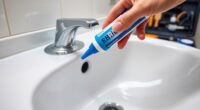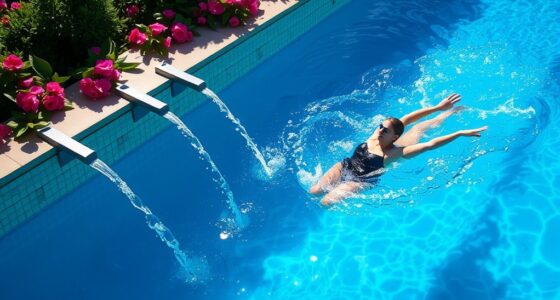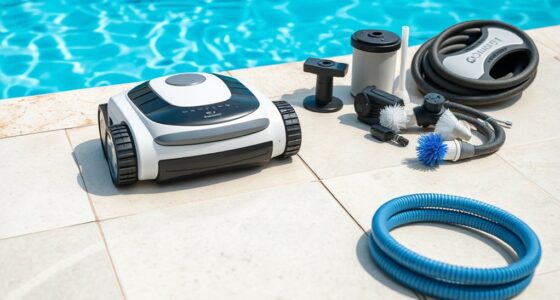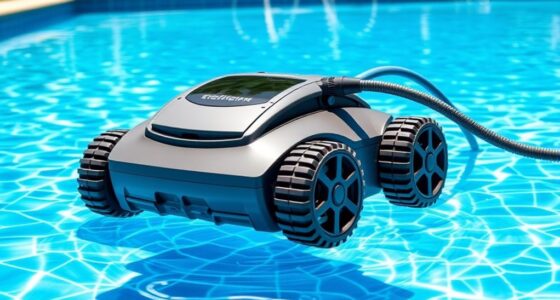Even with automatic pool cleaners, you still need to handle essential manual tasks. Skim the surface regularly to remove debris and brush the walls and floor weekly to prevent algae buildup. Check and balance chemical levels, especially pH and chlorine, for safe water. Empty skimmer and pump baskets often, inspect equipment for wear, and clean filters to keep everything running smoothly. Staying on top of these tasks guarantees a clean, clear pool—if you continue, you’ll discover how to keep it in top condition.
Key Takeaways
- Regularly skim the pool surface to remove floating debris and prevent clogging of automatic cleaners.
- Manually brush walls and floors weekly to prevent algae buildup and maintain water clarity.
- Check and clean skimmer and pump baskets frequently to ensure proper filtration and system efficiency.
- Monitor and adjust chemical levels, including pH and chlorine, for safe, balanced water.
- Inspect and maintain pool equipment and filters to keep the entire system operating effectively.
Skimming the Pool Surface Regularly
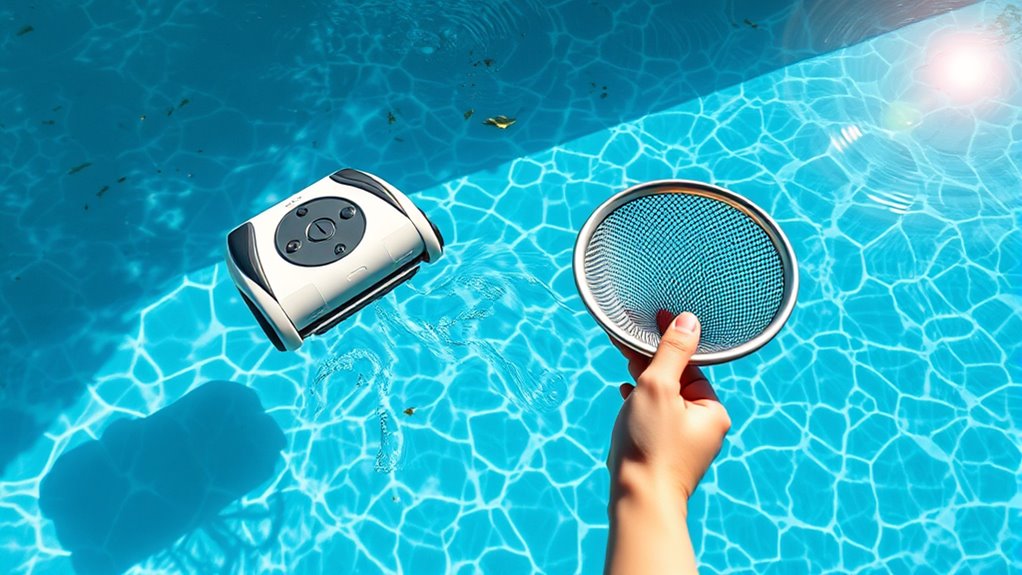
Regularly skimming the pool surface is a simple yet effective way to keep your pool clean. By removing debris from the pool surface, you prevent it from sinking and causing water quality issues. Use a net or a skimmer to quickly gather leaves, insects, and other floating debris. Doing this daily or every other day minimizes the workload for your automatic cleaner and helps maintain clear, inviting water. Pay close attention to the pool surface during skimming, especially in windy or fall seasons when debris accumulates rapidly. This simple task not only keeps your pool looking inviting but also reduces the chances of clogged filters and algae growth. Regular surface skimming is an essential manual step to support your automatic cleaner’s efficiency. Additionally, maintaining proper color accuracy in your pool lighting can enhance visibility and overall aesthetic appeal. Implementing routine water testing can also help monitor chemical levels, ensuring a safe and healthy swimming environment. Incorporating manual cleaning practices like surface skimming can significantly extend the lifespan of your automatic pool cleaner and improve overall pool hygiene. Regularly inspecting and cleaning your pool’s filter system can further optimize filtration and prevent debris buildup. Proper maintenance practices are crucial for long-term pool health and efficiency.
Checking and Adjusting Chemical Levels
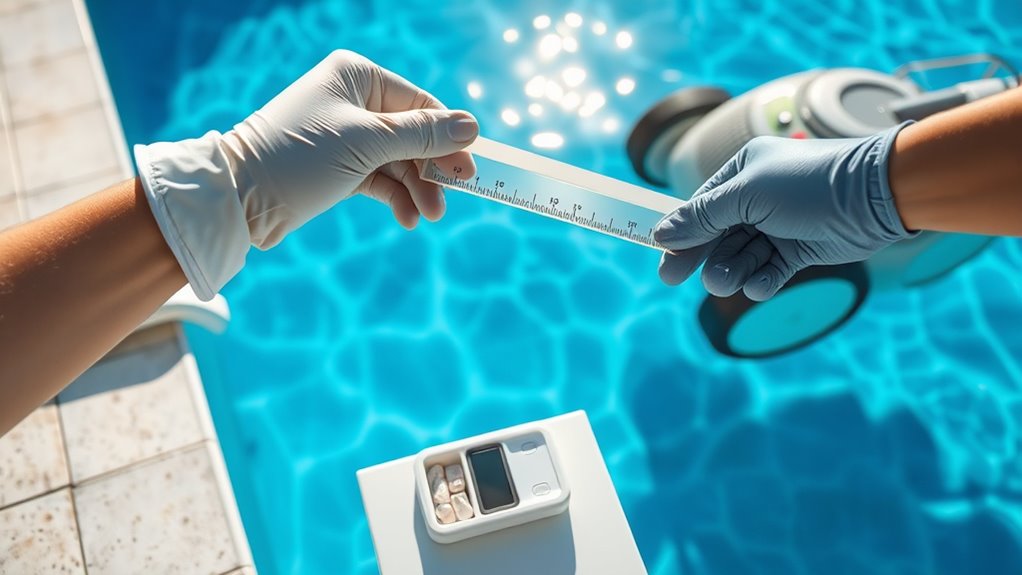
You need to regularly test your pool’s chlorine levels to keep the water safe and clear. Make sure the pH stays balanced to prevent irritation and equipment damage. When adding chemicals, follow the instructions carefully to maintain proper levels and keep your pool inviting. Remember, proper pool maintenance is essential for a safe and enjoyable swimming environment. Additionally, understanding chemical balance can help prevent costly issues and ensure your pool remains in optimal condition. Regularly monitoring air quality around your pool area can also contribute to a healthier swimming experience. Staying informed about industry transformations can help you adopt innovative solutions for better pool care.
Test Chlorine Regularly
Since maintaining proper chlorine levels is essential for a safe and clean pool, it’s important to test the water frequently. Regular water testing guarantees your chlorine stays within the ideal range, preventing bacteria and algae growth. To do this effectively, use a reliable test kit and check your chlorine levels at least 2-3 times a week during peak usage. Here’s a quick guide:
| Test Frequency | Action |
|---|---|
| Daily | Test chlorine before swimming |
| Weekly | Perform thorough water testing |
| After heavy use | Test chlorine immediately |
| After rain | Check water quality |
| Seasonal | Full chemical balance check |
Consistent test chlorine levels help you maintain a safe and enjoyable pool environment. Proper testing methods are crucial, and using approved testing kits ensures accuracy and reliability. Regular testing helps you detect chemical imbalances early, including pH fluctuations, making adjustments easier and preventing issues before they become serious.
Balance Ph Levels
Maintaining proper chemical balance in your pool involves monitoring and adjusting pH levels to make certain water stays safe and comfortable for swimmers. When pH is off, algae can thrive, and your pump maintenance becomes more challenging. Regularly check your pH levels and make adjustments as needed. Keeping pH balanced helps prevent algae growth and guarantees your automatic cleaner works efficiently. Proper use of chemicals is essential for maintaining this balance. Additionally, understanding environmental considerations can help you adopt sustainable practices that protect your local ecosystem. Incorporating eco-friendly water treatment methods can further enhance your pool maintenance routine and reduce chemical reliance. Studies also show that the presence of security systems in homes can improve safety and deter intruders. Being aware of AI-driven platforms in your neighborhood can also promote smarter safety measures and community awareness.
Add Chemicals Properly
Regularly checking and adjusting chemical levels guarantees your pool stays safe and clean. When adding chemicals, always prioritize pool chemical safety by following manufacturer instructions and wearing protective gear. Test your water frequently to determine if chlorine, pH, alkalinity, or other chemicals need adjustment. Add chemicals slowly and carefully, avoiding overcorrection, which can harm swimmers or damage equipment. Store chemicals according to chemical storage guidelines, keeping them in a dry, well-ventilated area away from direct sunlight and incompatible substances. Proper chemical handling minimizes risks and ensures your pool maintains proper sanitation and clarity. Regular testing and adjustment help prevent water imbalance, which can lead to algae growth or corrosion of pool equipment. Understanding chemical interactions can further improve your pool maintenance routine. Additionally, staying informed about regulatory standards can help you maintain compliance and safety. Proper chemical management also involves knowing the KTM electric dirt bike pricing, as equipment maintenance costs can impact overall pool care budget. Being aware of safety precautions and potential hazards when handling chemicals is crucial for safe pool operation. Adhering to these steps helps prevent corrosion, algae growth, and water imbalance, making your pool safer and more enjoyable for everyone.
Brushing the Pool Walls and Floor
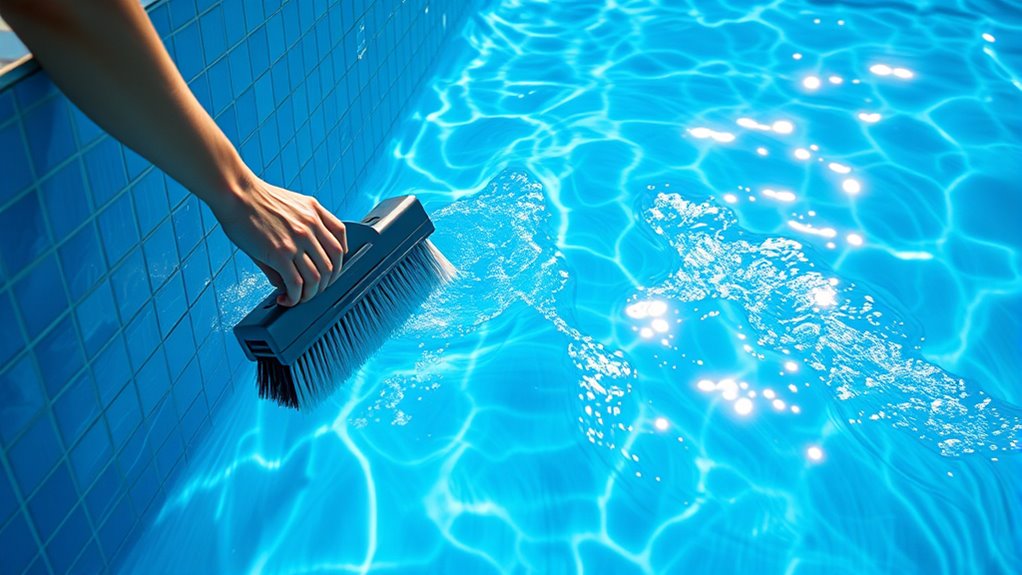
Regularly brushing your pool walls and floor helps prevent algae buildup and keeps your water sparkling. Use effective techniques like gentle scrubbing with appropriate brushes and focus on high-traffic areas. You should brush the surfaces at least once a week for ideal cleanliness and maintenance. Incorporating routine maintenance practices can further ensure your pool stays clean and inviting.
Effective Wall Brushing Techniques
To keep your pool clean and inviting, effective wall brushing is essential, especially since algae and dirt tend to cling to surfaces over time. Proper wall scrubbing helps prevent buildup and maintains water clarity. Focus on these techniques for best results:
- Use a stiff-bristled brush suited to your pool surface.
- Start at the top and work downward to avoid spreading debris.
- Use circular motions for thorough algae removal and wall scrubbing.
- Pay extra attention to corners and steps where grime accumulates.
Regular wall brushing keeps algae at bay and ensures your pool stays sparkling. Remember, consistent cleaning with the right tools considerably reduces the need for chemical treatments and makes your automatic cleaner more effective. Proper technique is key to maintaining a pristine pool.
Frequency of Manual Cleaning
Maintaining a consistent cleaning schedule is essential to keep your pool in top condition and prevent algae buildup. You should brush your pool walls and floor at least once a week to disrupt any developing algae and remove stubborn debris. Regular brushing helps keep the surface clean and reduces the workload for your automatic cleaner. If you notice a buildup of pool algae or debris, increase your brushing frequency accordingly. This manual task guarantees thorough debris removal that automatic cleaners might miss, especially in hard-to-reach corners. Incorporating the right vacuum cleaner attachments can enhance the effectiveness of your manual cleaning routine. Staying informed about on-device AI capabilities can also assist in monitoring your pool’s condition through smart devices. By sticking to a routine, you ensure your pool stays clear, balanced, and inviting for swimmers.
Emptying and Cleaning the Skimmer and Pump Baskets

Since debris can quickly clog the skimmer and pump baskets, it’s important to empty and clean them regularly. A clogged skimmer basket prevents proper water flow, while a full pump basket can strain your pump and reduce efficiency. To keep your pool running smoothly:
Regularly clean skimmer and pump baskets to maintain optimal pool flow and equipment efficiency.
- Remove debris from the skimmer basket regularly
- Clear out leaves, bugs, and dirt from the pump basket
- Rinse out both baskets with a hose to remove stubborn dirt
- Check for any damage or cracks in the baskets and replace if needed
- Using the right vacuum filters can also help improve filtration performance and prolong equipment lifespan.
Doing this weekly helps maintain proper filtration and prolongs the life of your equipment. Remember, a clean skimmer basket and pump basket ensure your automatic cleaner works effectively and keeps your pool crystal clear.
Inspecting and Maintaining Pool Equipment
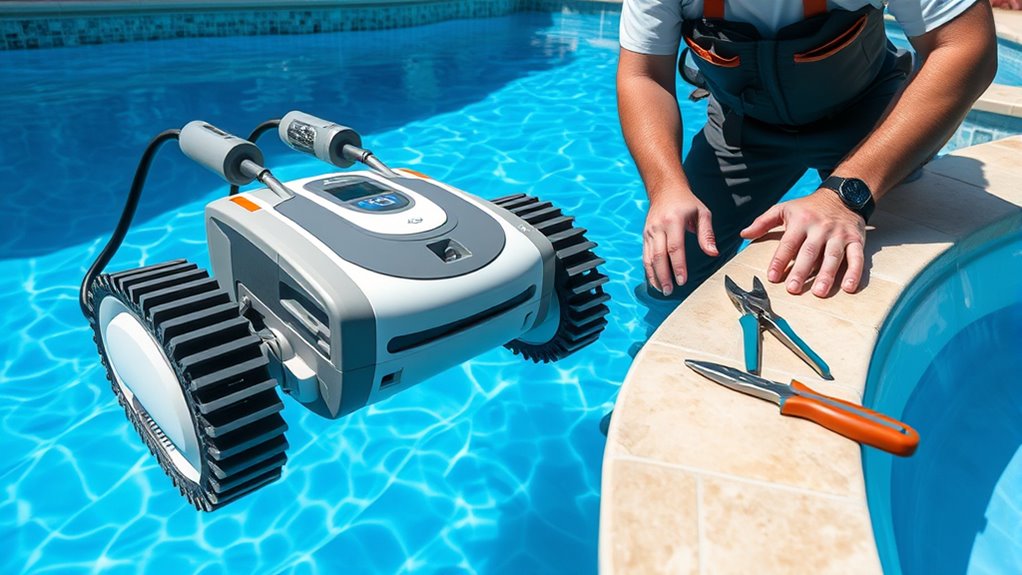
Regularly inspecting your pool equipment guarantees everything functions properly and helps catch issues early. You should check your automatic pool cleaners for wear or damage, ensuring they operate smoothly. Use pool maintenance tools like a wrench or screwdriver to tighten fittings and clear blockages. Keep an eye on the pump and skimmer baskets, removing debris that could hinder performance. Here’s a quick overview:
| Equipment | Inspection Task | Maintenance Tip |
|---|---|---|
| Automatic pool cleaners | Check brushes and hoses for damage | Replace worn parts promptly |
| Pump & Skimmer | Inspect for leaks or clogs | Clean and tighten connections |
| Filters | Examine for dirt buildup | Rinse or replace filter media |
| Valves & Fittings | Ensure they’re secure and leak-free | Tighten fittings as needed |
Stay consistent to keep your pool running efficiently.
Cleaning the Pool Filter System

Cleaning your pool filter system is essential for keeping your pool water clear and healthy. Regular maintenance ensures the best filtration and prevents debris buildup. Start by performing filter backwashing, which removes trapped dirt and contaminants from sand or DE filters. For cartridge filters, carefully remove and clean the cartridges with a hose. While cleaning, check for damage or wear and replace parts as needed. Don’t forget to verify your chemical dosing levels; proper chemical balance supports filter efficiency and water clarity. Keep an eye out for these key tasks:
Regularly clean and inspect your pool filter to maintain water clarity and filter efficiency.
- Perform filter backwashing regularly
- Clean or replace filter cartridges
- Inspect for leaks or damage
- Adjust chemical dosing as needed
Consistent cleaning extends filter lifespan and maintains water quality, making your automatic cleaner’s job easier.
Inspecting for and Repairing Leaks or Damage
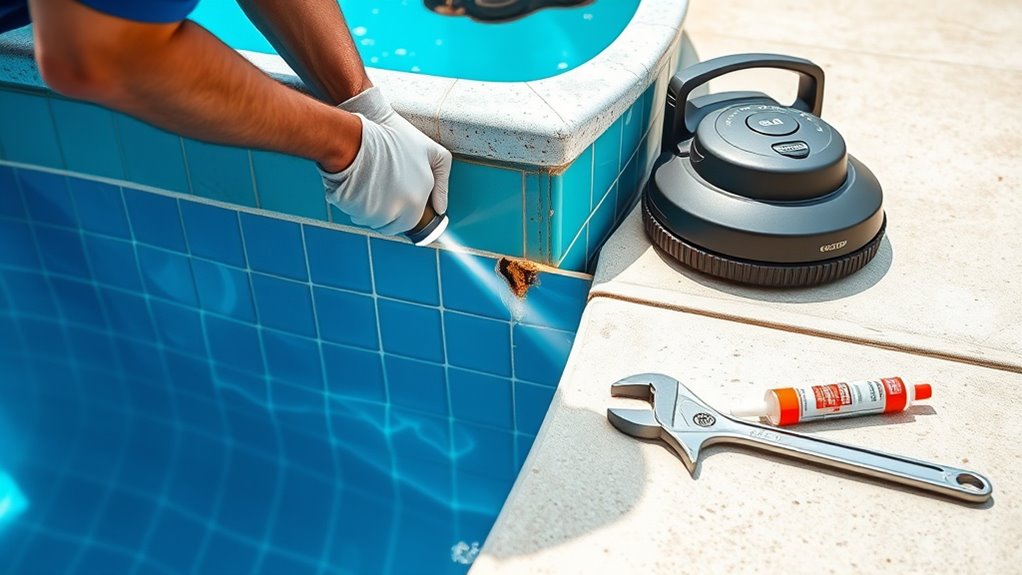
Inspecting your pool for leaks or damage is a crucial step in maintaining its overall health. You should regularly check for signs like reduced water levels, cracks, or wet spots around the pool. Leak detection involves listening for hissing sounds or observing uneven water loss. Damage repair might include patching cracks or replacing worn parts promptly. Use this table as a quick guide:
| Issue | Signs | Action |
|---|---|---|
| Leaks | Water level drops unexpectedly | Seal cracks, tighten fittings |
| Cracks or chips | Visible damage on pool surface | Patch or replace affected area |
| Equipment damage | Strange noises, malfunction | Repair or replace equipment |
Stay vigilant to catch issues early and keep your pool in top shape.
Managing Water Levels for Optimal Circulation

Maintaining the correct water level is key to guaranteeing your pool’s circulation system functions properly. If water is too low or too high, it hampers water circulation and reduces pump efficiency. To keep things ideal:
- Keep water at the skimmer level for smooth water flow
- Regularly check and refill to compensate for evaporation
- Avoid overfilling, which can cause water to spill and strain the pump
- Ensure debris doesn’t clog skimmers or return jets, disrupting circulation
Proper water levels help your automatic cleaner operate effectively and protect your pump from unnecessary wear. By maintaining the right level, you guarantee consistent water flow, better filtration, and longer equipment lifespan. Regularly monitoring water levels is a simple yet essential task for efficient pool management.
Monitoring Pool Water Temperature and Ph Balance
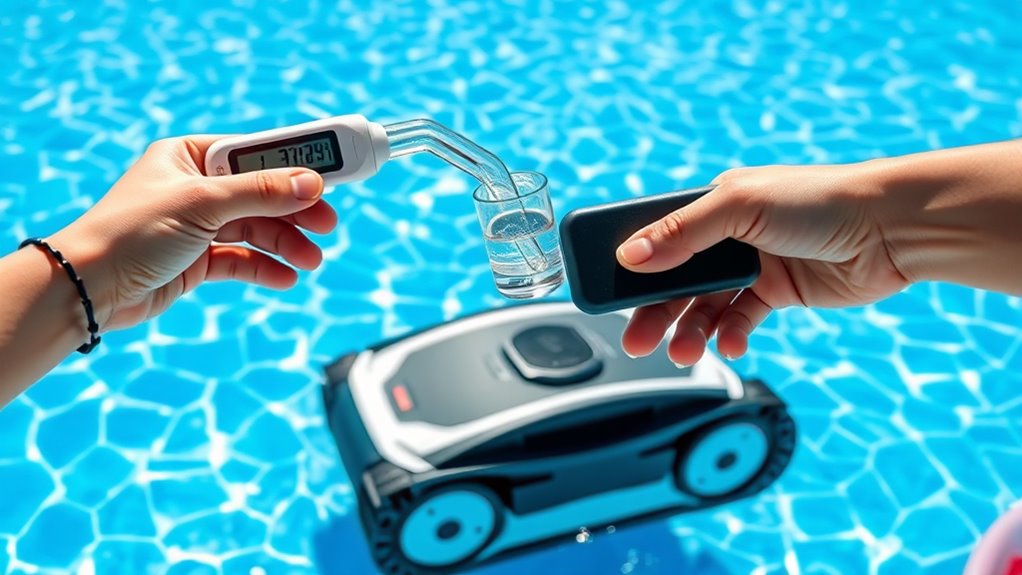
Monitoring your pool’s water temperature and pH balance is essential to keep the water safe and comfortable for swimmers. Properly maintained pool water chemistry prevents issues like algae growth and skin irritation. Use test kits regularly to check pH levels and alkalinity, adjusting as needed. Automatic temperature control systems help maintain a consistent, comfortable water temperature, reducing manual adjustments. Here’s a quick reference:
| Parameter | Ideal Range |
|---|---|
| Water Temperature | 78°F to 82°F |
| pH Level | 7.2 to 7.8 |
| Total Alkalinity | 80 to 120 ppm |
Regular monitoring ensures your automatic systems and chemicals work effectively, keeping your pool inviting and safe.
Frequently Asked Questions
How Often Should I Replace the Automatic Pool Cleaner’S Brushes or Belts?
You should replace your automatic pool cleaner’s brushes and perform belt maintenance regularly. Typically, check the brushes every 2-4 weeks and replace them when they show signs of wear or damage. Belt replacement depends on usage, but generally, inspect it monthly and replace it if it’s frayed or broken. Keeping up with brush replacement and belt maintenance ensures your cleaner runs efficiently and prolongs its lifespan.
What Safety Precautions Should I Take When Maintaining Pool Equipment?
When maintaining pool equipment, always prioritize safety. Make sure to disconnect power before working on electrical components to avoid hazards. Keep a close eye on pool cover safety, ensuring it’s secure to prevent accidents. Avoid working in wet conditions to reduce electrical risks. Use insulated tools and wear protective gear. Regularly inspect cords and connections for damage, and never bypass safety features. Staying cautious protects you from potential electrical hazards and accidents around your pool.
Can I Use Household Cleaning Products on My Pool’S Surfaces?
You shouldn’t use household cleaning products on your pool’s surfaces, as they can damage the material and throw off your pool water testing. Instead, stick to products specifically designed for pools. Proper pool chemical storage is essential to keep chemicals safe and effective. Regularly test your pool water to monitor chemical levels, ensuring safe and clean swimming conditions without risking damage or health hazards.
How Do I Troubleshoot Common Issues With Automatic Pool Cleaners?
Imagine your automatic cleaner throwing a tantrum, refusing to work. For automatic cleaner troubleshooting, start by checking the power supply and brushes—sometimes they just need a good kick. Clear debris from the filter and verify the hoses aren’t kinked. For common issue remedies, adjust the float or reset the unit. If problems persist, consult the manufacturer’s manual—sometimes, even robots need a little guidance.
Are There Environmental Considerations When Choosing Pool Chemicals?
When choosing pool chemicals, you should consider environmental considerations to protect your surroundings. Opt for eco-friendly chemicals and environmentally safe options that reduce harmful runoff and chemical exposure. These options help minimize your pool’s environmental impact while maintaining water quality. Always read labels and follow usage instructions, ensuring you use the safest, most sustainable products available. This approach keeps your pool clean and eco-conscious, supporting a healthier environment overall.
Conclusion
Just like Da Vinci’s meticulous sketches, your pool needs careful attention beyond automatic cleaners. Regular manual tasks ensure your oasis remains pristine and inviting. By staying vigilant—skimming, checking chemicals, and inspecting equipment—you keep your pool in harmony, much like tuning a finely crafted instrument. Remember, even the most advanced tools can’t substitute your hands-on care. With dedication, your pool will continue to be a sparkling retreat, timeless in its beauty and function.

